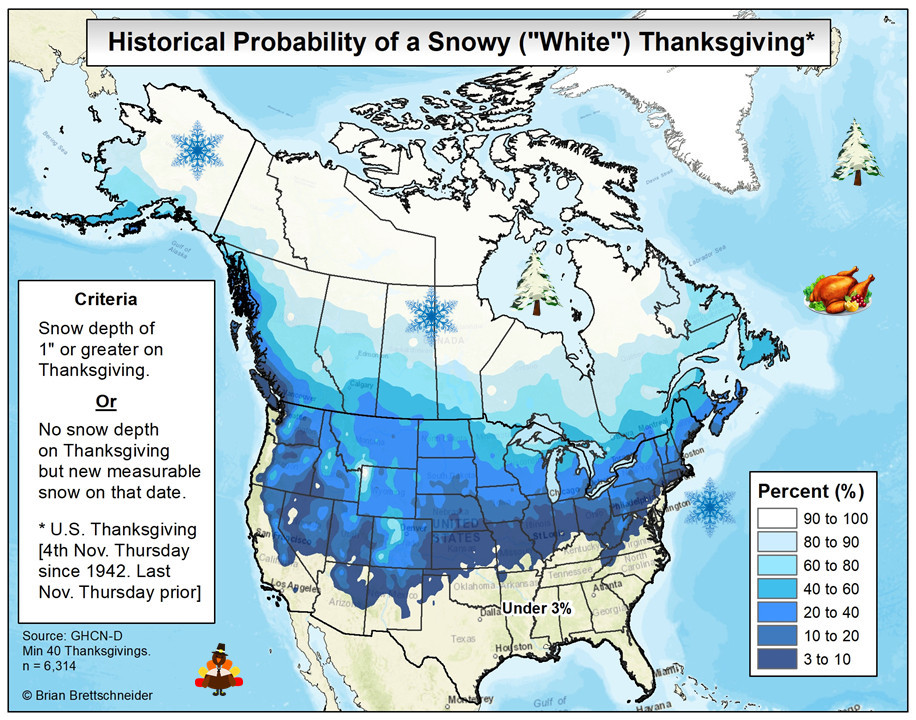Will the US Have a Snowy White Thanksgiving?

It's common to hear people "dreaming of a white Christmas," but what about longing for a snowy white Thanksgiving? If you're in the "snowy Thanksgiving" camp, you now have a place to turn: the Twitter account of @Climatologist49.
In anticipation of Thanksgiving, Brian Brettschneider, a climate researcher at University of Alaska Fairbanks, analyzed data from thousands of U.S. and Canadian weather stations from the past 154 years. Brettschneider, who runs theTwitter account, set out to see whether it typically snowed on Thanksgiving Day at different locations.
In most cases, the farther inland and north a state's location was, the greater historical probability it had of receiving at least 1 inch (2.5 centimeters) of snow on Thanksgiving, he found. [10 Surprising Ways Weather Has Changed History]
To make the map, Brettschneider looked at Thanksgiving Day weather data from 6,314 weather stations in the United States and Canada. He included only weather stations that had at least 40 years' worth of Thanksgiving data. The earliest date is from Fort Garland, Colorado, in 1863.
Some weather stations recorded snow on Thanksgiving Day every year, including a station at Old Faithful, Wyoming, which has "a perfect record" of Thanksgiving snow, dating back to 1906 (although not every year has records), Brettschneider said.
Likewise, it snowed on all 69 of the Thanksgiving Day archives logged at Snake River, Wyoming, he said. Fairbanks, Alaska, also had 69 out of 69, another perfect snowy record, Brettschneider said.
The state of Florida has just one record of snow on Thanksgiving. On Nov. 28, 1912, Mount Pleasant, Florida, celebrated a half inch of snow (1.3 cm), Brettschneider tweeted.
Sign up for the Live Science daily newsletter now
Get the world’s most fascinating discoveries delivered straight to your inbox.
This map isn't a weather forecast — you'll have to check the National Weather Service for that — "although, if you're visiting Minneapolis on Thanksgiving in any given year, there's about a 50 percent chance that it will be snowing or have snow on the ground [based on previous records]," Brettschneider said.
Brettschneider also looked at other weather records. In another tweet, he noted that "No station has ever hit 100°F[ahrenheit, 37 degrees Celsius] on Thanksgiving. The closest was 97°F at the Falcon Lake, TX, RAWS station on Nov. 25, 2010."
To find the hottest and coldest Thanksgivings for the entire United States (excluding Alaska and Hawaii), Brettschneider took the average daily temperature of every Thanksgiving on record. The warmest Thanksgiving was in 1998, when the national average was 48 degrees F (8.8 degrees C). This warm weather was likely due, in part, to El Niño, a climate cycle that warms the ocean's surface in the central and eastern Pacific Ocean.
The coldest Thanksgiving for the United States happened in 1898, but that year isn't well-sampled, Brettschneider tweeted. The next coldest Thanksgiving was in 1993, when the national average was 28 degrees F (minus 2.2 degrees C), he said. [Weirdo Weather: 7 Rare Weather Events]
It's important to note that Thanksgiving doesn't happen on the same day every year. The holiday was celebrated on the fourth Thursday of November from 1863 until 1939. In that year, President Franklin D. Roosevelt moved the holiday to the third Thursday of the month, in hopes of giving shoppers more time to stimulate the economy between Thanksgiving and Christmas, according to the History Channel. In 1941, Roosevelt moved Thanksgiving back to the fourth Thursday, at the insistence of Congress.
Because of these changes, the holiday has fallen on any one of nine days throughout the years, Brettschneider said.
Even so, it's fun to see what places got snow on Thanksgiving. In this map, Brettschneider shows which weather stations have measured any snow (dark blue) or trace snow (light blue) on turkey day. According to the map, even Harlingen, Texas, a mere 13 miles (20 kilometers) north of the U.S.-Mexico border, has seen snow, with trace amounts falling on Nov. 24, 1938.
"Thanksgiving is a big travel day, so I think snow causes anxiety for people driving, but that notwithstanding, I think people get excited about snow on holidays," Brettschneider said.
He also tweets weather records for other holidays, including Halloween and Christmas, he said.
Original article on Live Science.

Laura is the archaeology and Life's Little Mysteries editor at Live Science. She also reports on general science, including paleontology. Her work has appeared in The New York Times, Scholastic, Popular Science and Spectrum, a site on autism research. She has won multiple awards from the Society of Professional Journalists and the Washington Newspaper Publishers Association for her reporting at a weekly newspaper near Seattle. Laura holds a bachelor's degree in English literature and psychology from Washington University in St. Louis and a master's degree in science writing from NYU.









